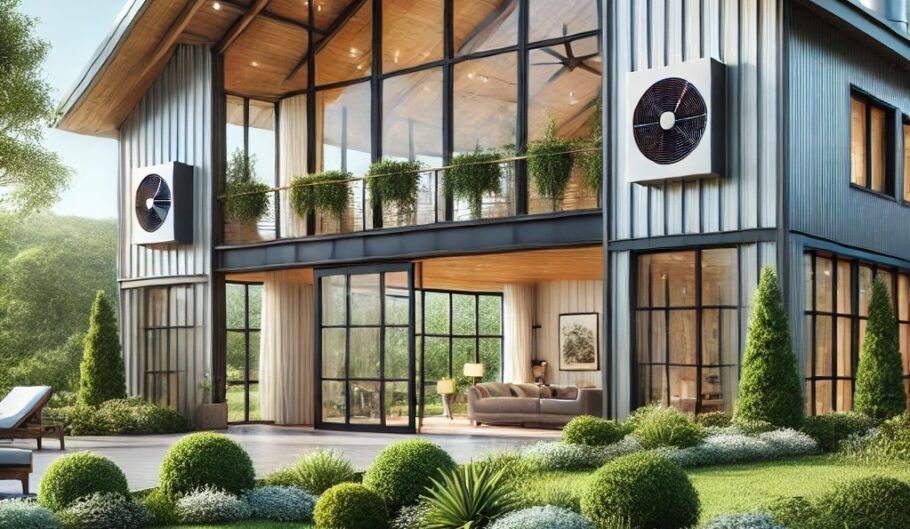Barndominiums—those trendy hybrids of barn and home—are known for their rustic charm, spacious interiors, and customizable layouts. However, because they’re typically constructed from metal and have open floor plans, heating and cooling a barndominium efficiently can be a bit more complex than a conventional home. If you’re building, renovating, or currently living in a barndominium, understanding your climate control options is key to year-round comfort and energy savings.
In this blog post, we’ll explore the best ways to heat and cool a barndominium efficiently, including insulation strategies, HVAC options, zoning, and smart technology. Whether you’re in the sweltering South or the frosty North, you’ll find practical tips to keep your space comfortable without breaking the bank.
Why Barndominiums Are Unique in Heating and Cooling
Unlike traditional stick-built homes, barndominiums often use steel frames and sheet metal siding, which can be less insulating than wood. This makes them prone to temperature swings if not properly designed. Their large open interiors, tall ceilings, and sometimes vast garage or workshop areas can also complicate temperature control.
Key Challenges:
- Thermal Conductivity of Metal: Metal transfers heat and cold quickly, which means without proper insulation, your barndo can feel like an oven in summer and a freezer in winter.
- Open Floor Plans: It’s harder to zone or control temperatures in distinct areas.
- High Ceilings: Warm air rises, which can make it harder to keep the living space warm in colder months.
With these challenges in mind, let’s dive into how you can heat and cool your barndominium efficiently.
1. Start with Proper Insulation
The Most Important Step
Insulation is the foundation of any energy-efficient barndominium. Without it, your heating and cooling systems will be constantly overworked.
Best Insulation Types for Barndominiums:
- Spray Foam Insulation: This is the most effective choice for barndos. It expands to seal gaps and acts as both insulation and a vapor barrier.
- Rigid Foam Board: Good for metal walls and ceilings, and can be layered.
- Fiberglass Batts: Budget-friendly and easy to install, but less effective if there are air leaks.
Where to Insulate:
- Walls and Roof: Always insulate the exterior envelope.
- Slab Foundation: Add rigid insulation under the slab or around its perimeter.
- Garage/Workshop Areas: Don’t forget to insulate attached utility spaces if they’re conditioned.
Bonus Tip: Use radiant barriers on the roof underside in hot climates to reflect heat and reduce cooling costs.
2. Choose the Right HVAC System
The type of heating and cooling system you choose depends on your climate, budget, and barndominium layout.
Central HVAC System (Ducted)
- Best for larger barndos or multi-room layouts
- Can provide both heating and cooling
- Works well with zoning systems
Pros: Whole-house comfort, works with smart thermostats
Cons: Ductwork can be expensive and less efficient if poorly installed
Mini-Split Systems (Ductless)
- Great for open floor plans and small barndos
- Ideal for zoning rooms separately
- High energy efficiency
Pros: No duct losses, customizable temperatures per room
Cons: Initial cost can be higher, aesthetics may not appeal to everyone
Geothermal Heat Pumps
- Best for long-term energy savings
- Extracts heat from the ground for efficient heating/cooling
Pros: Extremely energy-efficient, lower operational costs
Cons: High upfront cost, requires land for ground loops
Wood Stoves or Pellet Stoves
- Supplemental heating option for rustic feel
- Good for off-grid setups
Pros: Cozy atmosphere, great backup heat source
Cons: Not ideal as the primary system, maintenance required
3. Use Zoning to Control Temperatures by Area
Barndominiums often include large, open spaces alongside smaller, enclosed rooms like bedrooms, offices, or bathrooms. Instead of heating or cooling the entire structure equally, zoning allows you to condition specific areas independently.
Zoning Options:
- Ducted Zoning: Motorized dampers in the ductwork control airflow to different zones.
- Mini-Split Systems: Each indoor unit acts as its own zone.
- Smart Vents: Automated vents that open or close based on temperature needs.
Benefits of Zoning:
- Reduces energy usage by focusing on occupied spaces
- Customizable comfort in different rooms
- Helps balance temperature inconsistencies caused by high ceilings or large windows
4. Invest in Smart Thermostats and Automation
Modern thermostats do more than just adjust the temperature—they learn your habits, respond to your smartphone, and adjust in real-time for maximum efficiency.
Recommended Features:
- Geofencing: Adjusts the temperature based on your location
- Scheduling: Heats or cools your home around your daily routine
- Remote Control: Adjust settings from your phone or voice assistant
Popular brands like Nest, Ecobee, and Honeywell offer smart thermostats that integrate with other systems, allowing you to control multiple zones and monitor your energy use.
5. Seal Air Leaks and Improve Ventilation
Efficiency isn’t just about your HVAC—it’s also about preventing loss. Air leaks around doors, windows, and vents can waste energy.
Air Sealing Tips:
- Use caulk or weatherstripping around windows and doors
- Seal around light fixtures, outlets, and attic access points
- Insulate ducts to prevent heat loss in unconditioned spaces
Don’t Forget Ventilation:
While sealing is critical, good ventilation ensures air quality and moisture control. Install:
- Energy Recovery Ventilators (ERVs) or Heat Recovery Ventilators (HRVs) to bring in fresh air without sacrificing efficiency
- Exhaust fans in kitchens, bathrooms, and workshops
6. Make Passive Design Work for You
Design choices made during construction or renovation can greatly affect your heating and cooling needs.
Passive Heating and Cooling Ideas:
- Orientation: Face windows south to maximize winter sun exposure
- Overhangs and Awnings: Block harsh summer sun
- Thermal Mass: Use concrete floors to absorb and release heat
- Window Treatments: Use thermal curtains, blinds, or reflective films to control solar gain
Even small design tweaks can make a big difference in how your barndo holds or releases heat.
7. Consider Renewable Energy Options
If you want to cut your utility bills and carbon footprint, pairing an efficient HVAC system with renewable energy can make your barndominium even more sustainable.
Solar Panels:
- Offset electricity use from HVAC systems
- Can be installed on metal roofs with mounting brackets
- Pair with battery storage for off-grid capability
Solar Water Heaters:
- Reduce the cost of heating water, especially if you have radiant floor heating
Final Thoughts
Heating and cooling a barndominium efficiently is all about planning, investing in quality systems, and maximizing energy performance through insulation, smart technology, and good design. Whether you’re building new or upgrading an existing structure, you have plenty of options to stay comfortable year-round without inflating your energy bills.
By combining the right heating and cooling system with airtight construction, passive design elements, and modern tech, your barndominium can be both cozy and cost-effective—no matter the season.

